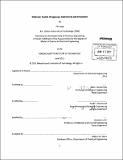Molecular studies of aggrecan : experiments and simulations
Author(s)
Liang, Fei, Ph. D. Massachusetts Institute of Technology
DownloadFull printable version (11.07Mb)
Other Contributors
Massachusetts Institute of Technology. Dept. of Chemical Engineering.
Advisor
Alan J. Grodzinsky, Paula T. Hammond and Christine Ortiz.
Terms of use
Metadata
Show full item recordAbstract
Located in the extracellular matrix (ECM) of the cartilaginous tissues such as human intervertebral disc, the large self-assembling proteoglycans, aggrecan, are essential for the disc in resisting multiaxial compressive loads. Aggrecan degradation, a combinational result of abnormal and/or reduced cellular synthesis and proteolytic cleavage, leads to a reduction in the disc functionality. The knowledge of how aggrecan distributes at different stage of degradation on a molecular level can help reveal both the processes of aggrecan degradation and that of human intervertebral disc degeneration and repair. This thesis will cover both the experimental work and the simulation work in an attempt to fully understand aggrecan structure and the origin of its mechanical properties. The experimental study utilizes high resolution atomic force microscopy (AFM) to directly visualize the single molecular conformation of aggrecan before and after removal of keratan sulfate (KS) or chondroitin sulfate (CS) glycosaminoglycans (GAGs) via enzymes Keratanase II (K'ase) and Chondroitinase ABC (C'ase) respectively. The aggrecan was extracted and purified from the intervertebral disc of a 24-year old human (obtained from the Shriner's Hospital, Montreal) and separated into two pools: the HA-associated pool is composed of aggrecan proteoglycans that were originally attached to hyaluronic acid (HA) in vivo; while the non-HA-associated pool constitutes the aggrecan that lack in G1 domains and were floating around the ECM. The aggrecan solutions were deposited on 3-aminopropyltriethoxysilane functionalized mica substrates and imaged via tapping mode AFM (tip radius <10 nm) after air dried. The results have shown that aggrecan from normal human disc (24 yr) appears highly degraded, composed mainly of short fragments, and that the non-HA associated molecules are composed primarily of the degradation products and arise because of entrapment in the unique matrix organization of the disc. We can infer that the trace length of aggrecan core protein is extended by GAG chains, specifically by CS GAGs, and this hypothesis leads to study GAG specifically by Molecular Dynamic (MD) Simulations. It has been found that the sulfation type (4- versus 6-sulfation) and sulfation pattern vary with age in articular cartilage and intervertebral disc. This MD simulation study developed an implicit solvation model of three types of tetrasaccharides of both sulfated and unsulfated chondroitin, namely, chondroitin 4-sulfate (C4S), chondroitin 6-sulfate (C6S) and chondroitin (CN). In this model, water is treated implicitly as a continuum medium by incorporating its electrostatic screening and viscous effects. The structural analysis on the atomic level based on the temporal dynamics of these tetrasaccharides suggested a closer similarity between 4 and 6-sulfated chondroitin as compared to between sulfated and unsulfated chondroitin. To note, this implicit solvation model provides a consistent result with explicit solvation models of GAGs, indicated by the maintenance of 3-fold helix structure. We have also observed the intramolecular hydrogen bonds that are present intermittently on the sub-nanosecond time scale and cooperate with the glycosidic torsion angles. In future, a coarsegrained model based on this all-atom simulation will provide us with a better understanding of the dynamic properties of aggrecan proteoglycans.
Description
Thesis (S.M.)--Massachusetts Institute of Technology, Dept. of Chemical Engineering, 2010. Cataloged from PDF version of thesis. Includes bibliographical references (p. 77-82).
Date issued
2010Department
Massachusetts Institute of Technology. Department of Chemical EngineeringPublisher
Massachusetts Institute of Technology
Keywords
Chemical Engineering.